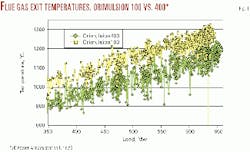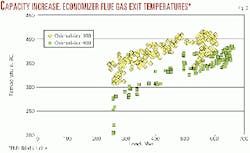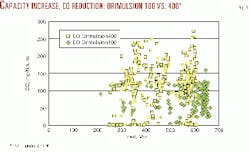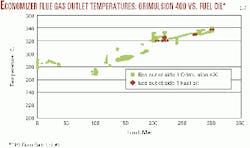Orimulsion's 20-year development history includes basic and applied research, process scale-up to industrial level, commercial utilization, and the creation of new generations in order to comply with technical and environmental challenges from worldwide users.
Recently, Orimulsion has been redesigned to improve its performance as a fuel. The Orimulsion new generation has been called Orimulsion400, its constituents still being 70% bitumen (extracted from the Orinoco heavy oil belt, in Venezuela), 30% water, and a stabilizer agent or surfactant.
One of the main changes is a total "new surfactant package" (NSP) and the exclusion of magnesium nitrate from the formulation. The NSP was specially designed to meet the new regulations regarding tensoactive compounds established by the European Economic Community (EEC) for the new millennium; it also focused on customers' needs, taking into account new, higher standards to minimize environmental impact.
The new generation has been developed as a more environmentally friendly, cost-effective energy source. Since 1991, Orimulsion has been used as fuel for cement and power plants. Alternative new uses are being developed for diesel engines and gasification, which could further enhance the future applications of this fuel.
This article describes the product's evolution in order to meet strict environmental regulations and economic constraints. It also contains test results from diverse power plants showing comparative performance improvements associated with Orimulsion400 fuel-oil-like behavior.
New generation Orimulsion
Since the early 1980s, Petróleos de Venezuela SA (PDVSA) has been working on the technique for dispersing natural bitumen in water in order to commercialize the vast reserves existing in Venezuela's Orinoco belt. The Orinoco belt is an area of about 20,000 sq miles that has estimated economically recoverable reserves estimated at 270 billion bbl.
Orimulsion is the product of this research and development effort. The product is a mixture of 70% bitumen and 30% water that can be handled at room temperature with standard equipment.
Furthermore, the presence of water improves the combustion characteristics of the natural bitumen. Today, Orimulsion is recognized as a power-plant fuel with more than 30 million tonnes used to date in commercial installations worldwide. Its applications vary from use in conventional power plants to cement kilns, including integrated gasification combined-cycle plants, diesel engines, and reburning applications.
Orimulsion development was implemented as a way to use the vast heavy oil reserves of the Orinoco belt and transport that resource to the coast for export as a new fuel for power generation. Commercially, Orimulsion is a fuel used as an alternative to coal and heavy fuel oil for power generation.
The driving forces behind the new Orimulsion formulation were customer's operational experience regarding fouling in boiler tubes during fuel combustion and growing regulatory constraints regarding nonylphenol etoxylates (NPE). The new-generation fuel, called Orimulsion400, was designed to overcome these two basic concerns.
The restrictions for NPE, originating with EEC, were more focused on the final destination of NPE detergents-aquatic systems such as marine habitats, rivers, and estuaries. The NPE present in Orimulsion is completely decomposed during combustion. However, PDVSA-Bitor decided to exchange it for a more-accepted surfactant in order to moderate the existing negative public perceptions associated with NPE.
Orimulsion combustion deposits on heat-transfer surfaces or tube fouling was mainly due to the 370 ppm magnesium additive in the fuel. This additive was put into the fuel as magnesium nitrate [Mg(NO3)2], a water-soluble compound, to avoid corrosion caused by vanadium pentoxide compounds. The reason for its addition was to form magnesium-vanadates with higher melting points to avoid high temperature corrosion.
The drawback was the formation of very small particles after combustion that fouled tube banks, not only because of inertial forces, but also thermophoretic forces, leading to a very uniform coverage pattern. These deposits could be removed by using conventional steam soot-blowers, but the number of soot-blowers required and the necessary frequency of their use made the operation more complex.
Changing the Orimulsion formulation was not an easy task because, in addition to considering the driving forces that motivated the changes, some basic handling parameters such as viscosity and storage recommendations had to be retained in order to comply with commercial specifications. Also, PDVSA-Bitor was facing possible future restrictions on the commercial availability of the new surfactants.
For this new formulation, PDVSA-Bitor tested more than 10 surfactant packages. A new surfactant package was selected that not only satisfied EEC guidelines but also keeps handling variables under control, lowers viscosity, and improves operational parameters such as pressure drop through pipelines and pumps, thus giving the customers a much better product.
The new formula has no magnesium. The consensus was that there was no need for it in terms of inhibiting high-temperature corrosion in boilers, as was demonstrated in pilot and commercial plant tests burning Orimulsion400. If any customer wishes to add magnesium for additional boiler protection, PDVSA-Bitor recommends doing it as a nonwater-soluble compound such as magnesium hydroxide.
The primary benefit of not adding magnesium to the fuel in a water-soluble form is the better furnace-wall heat absorption that is obtained, leading to lower back-end temperatures and less-frequent need for soot-blowing. In fact, Orimulsion behavior in fuel oil-designed units is similar to that of fuel oil performance, thus permitting the switch of these units to Orimulsion400 with only minor modifications.
Performance tests
The advantages with Orimulsion400 were demonstrated in pilot and full-scale commercial tests and in the commercial operation of power plants using this fuel.
Three different pilot-scale tests were performed in order to obtain preliminary data to evaluate the general performance of the new formulation compared with the earlier formulated Orimulsion, referred hereinafter as Orimulsion100. These pilot scale tests were performed at Energy & Environmental Research in California, DB Riley in Massachusetts, and PowerTechnology at Ratcliffe, Nottingham, UK.
The main results summarizing the differences between Orimulsion400 and Orimulsion100 performance are presented in Table 1.
SK Power commercial-scale test
A commercial-scale test was carried out using Orimulsion400 at the SK Power facilities in Denmark. This test was performed on Unit 5 at the Asnaes power station. Unit 5 is a Benson-type unit equipped with low-nitrogen oxide burners and designed to produce 1,962 tonnes/hr of steam (640 Mw) using coal or heavy fuel oil as fuel.
This plant had used Orimulsion100 since February 1995 and had a deposition rate of 45 Mw due to the high flue-gas exit temperature of over 100° C. caused by the tube bank fouling.
The first commercial-scale test with Orimulsion400 was performed in this unit during fourth quarter 1998.1 The test lasted for 7 weeks. The main results from the test can be summarized as follows:
- Reduction of 15% in carbon dioxide emissions compared with coal.
- Reduction of 45% in NOx emissions compared with coal.
- Maximum load reduction of 15 Mw. This was design-related rather than fuel-related.
- Production of industrial-grade gypsum.
- Reduction of about 60% in fly ash production.
CO2 emissions at the plant are under 80 mg/N cu m, which is comparable to heavy fuel oil and 15% lower than coal. NOx emissions are about 408 mg/N cu m (3% O2 dry) when using Orimulsion400.
The actual unit deposition rate is related to the lower flue-gas inlet temperatures at the reheater, probably caused by an improvement in the heat transfer of the tube banks prior to this equipment because of the totally new deposition pattern with Orimulsion400 when compared with coal.
In addition, atmospheric emissions of sulfur dioxide are under 340 mg/N cu m (3% O2, dry) using an existing scrubber with a sulfur removal efficiency of 95%. Particles are calculated to be about 175 mg/N cu m, but this number is reduced to 1 mg/N cu m after treatment in the electrostatic precipitator. After the demonstration test, SK Power decided to change over to Orimulsion400.
Figs. 1 and 2 show the capacity increase and the flue-gas exit temperatures for both Orimulsion formulations, as well as the NOx reduction during the commercial-scale test.
Commercial plant results
All power plants that previously used Orimulsion100 are now burning Orimulsion400.
A very close follow-up has been performed-and is still in progress-in order to accumulate reliable data to confirm Orimulsion400 performance.
Results from power plants located in Canada (New Brunswick Power [NBP]-Dalhousie power station), Italy (ENEL-Brindisi and Fiume Santo power stations), and Japan (Kashima Kita Electric's Kashima power station) show similar results to those obtained from pilot and commercial-scale tests. A summary of these results is shown in Fig. 3.2
NBP Dalhousie
NBP's Dalhousie power station began burning Orimulsion100 in 1994. In November 1998, NBP started the test with Orimulsion400, based on results from the pilot scale tests and the SK Power Asnaes plant performance.
The most impressive result is that the new formulation has allowed NBP to run both boilers without experiencing intermediate shutdowns between annual outages, and it has reduced the fuel consumption in Unit No.1 for the same power output. This occurred despite minor atomization difficulties that were experienced in this unit due to atomizer design problems.
The reason for the efficiency gain must be associated with the heat transfer pattern for Orimulsion400-totally different from the one shown by Orimulsion100-mainly because the fouling pattern changed dramatically (Fig.3).
The new formulation generates a heat-transfer pattern similar to the one seen when firing fuel oil (with some differences caused basically by the water content in the fuel), allowing operations to be similar to original design parameters.
Improvements in plant heat rate have been about 2-2.5% when comparing both Orimulsion formulations, thus giving the same power output but with lower Orimulsion400 consumption (Fig.3).
Dalhousie shows improvements in its environmental performance, except for NOx emissions that have not experienced any significant change. It is difficult to distinguish differences between the two Orimulsion formulations in this particular item because both units share a common stack, and NOx emissions are measured in the stack.
In addition, it must be recalled that Unit No.1 has experienced some atomizing problems, reflected in an oxygen (O2) imbalance. A carbon monoxide reduction of about 50% is indicative of a better-burning operation because no major modification was made to the system or its operating conditions.
Fig.4 shows the sulfur trioxide (SO3) tendency for both units. This is not a continuous reading but a spot check that was performed during the trial. As can be seen, the SO3 values have been reduced to values consistently below 12 ppm.
ENEL Brindisi
From February to October 1998, ENEL SPA in Brindisi Sud Unit 1 was firing Orimulsion100 with a reduced maximum capacity of about 570 Mw (660 Mw design capacity).
Similar to other power facilities, the main constraint to boiler load was the high flue-gas outlet temperature caused by a high deposition rate on the convective banks due to fouling.
After switching to Orimulsion400, a dramatic improvement in flue-gas outlet temperature allowed ENEL to reach design capacity with no other modification.
A lower amount of air used for combustion (compared with previous Orimulsion100) indicates better fuel atomization-combustion performance as well as better atomizer fine-tuning (Fig. 5).
The present Orimulsion400 excess oxygen is 0.5% instead of the original 1.4%, applied when using Orimulsion100.
Environmental regulations in Italy are among the strictest in the world. Controlled emissions include SO2, NOx, particulate matters, and CO.
All Brindisi Sud boilers are fitted with limestone-scrubber forced-oxidation towers to abate SO2 emissions.
Average current SO2 emissions are about 312 mg/N cu m, which are below the 400 mg/N cu m limit (3% excess O2, dry), enabling the production of salable gypsum as a byproduct for the wallboard industry.
CO emissions diminished about 35% with the formulation switch and the atomizer fine-tuning (Fig. 6). This result occurred not only because of the lower excess oxygen being used (0.5% O2 excess) but also because of improved combustion properties as was seen in previous pilot and commercial-scale tests.
The Brindisi Sud unit 1 is producing 161 mg/N cu m of NOx-200 mg/N cu m is the limit-and less than 5 ppm of SO3 at the stack. The particulate emissions were reduced to 13 mg/N cu m from about 25 mg/N cu m-the regulatory limit is 50 mg/N cu m-when Orimulsion400 was introduced.
ENEL Fiume Santo
ENEL Fiume Santo power station has four units. Unit Nos. 3 and 4, twin units with 320 Mw capacity each, are tangentially fired and were constructed by Franco Tosi SPA under CE license. They were designed for burning fuel oil or coal.
Both are equipped with over-fire air and selective catalytic reduction for NOx control. Unit No.3 uses fuel oil as its main fuel, and Unit No.4, Orimulsion400. Their being twin units offers the tremendous advantage of enabling a direct comparison between the combustion performance of Orimulsion400 and fuel oil (Fig. 7).
Unlike other power facilities, ENEL Fiume Santo Unit No.4 changed directly from fuel oil to Orimulsion400 without ever having used Orimulsion100 as fuel. Data gathered show similar primary super-heater and Economizer steam inlet-outlet temperatures for both fuels, indicating a similar heat transfer behavior through the boiler banks.
Also, the Economizer flue-gas exit temperatures are in the same range for both fuels and have the same water inlet-outlet conditions, which means, indirectly, similar heat transfer properties in all of the boiler tube banks (Fig. 8).
ENEL conducted a test on Fiume Santo unit No. 3 that ended in July 1999 and revealed the environmental performance characteristics shown in Table 2.3 As can be seen, the numbers are in full compliance with local Italian regulation. It must also be noted that the results from the test were obtained at high excess oxygen levels (7.09% average). A future reduction in this item must lead towards more greatly reduced CO and NOx values for Orimulsion400, as ENEL operators gain experience in the use of this fuel.
Kashima Kita
Kashima Kita is one of the most experienced Orimulsion users. Units 1 and 2 have used Orimulsion100 since 1991 and 1994, respectively, in a co-fire operation with high-sulfur fuel oil and asphalt.
In June 1999, after collecting other customers' evidence on Orimulsion400 benefits, Kashima Kita started burning the new formulation. As reported from Kashima Kita operational personnel during a visit to the power plant in Japan, changing to Orimulsion400 has decreased soot-blower operations from consecutive to intermittent and has allowed for a significant reduction in burner "suffocation."
Economizer flue-gas outlet temperature has decreased 100° C., and, as expected, the fouling pattern has changed dramatically compared with Orimulsion100. PDVSA-Bitor and Kashima Kita personnel expect to recover the original design operating parameters after the boilers are shut down for inspection and cleaning.
Unit No. 5 is a totally new unit that started operations, using Orimulsion400, in September 1999. It is burning Orimulsion400 as the only fuel. In this unit, 0.5% excess oxygen could be achieved, in contrast with 1.2% excess oxygen used initially at the start of the test, based on the company's previous experience of burning Orimulsion100 in Units 1 and 2.
Again, little fouling is observed in Unit 5, as in many other facilities using Orimulsion400, and the plant still has not experienced any burner suffocation. The soot-blowing frequency is high but not continuous.
As can be seen in Fig. 9, the Economizer flue-gas outlet temperature is lower for Orimulsion400 than for Orimulsion100, which denotes steady fouling condition (no accumulation) as expected, giving Orimulsion400 a more fuel-oil-like behavior.
From the environmental point of view, Kashima Kita has reported no deterioration on CO or NOx emissions for Units No. 1 and 2 when Orimulsion400 was introduced to replace Orimul sion100. No comparison can be made for Unit No. 5, because this unit just started operations with Orimulsion400. Nevertheless, Kashima Kita has reported no emissions values over the Japanese environmental regulations.
Orimulsion400 markets
Current production capacity is fully sold to customers, and there is an unsatisfied demand that is exerting pressure for a capacity increase. This increase can be made by building a new manufacturing plant (located at the terminal site) or increasing manufacturing capacity at Morichal. Fig. 10 shows the current PDVSA-Bitor projections for future Orimulsion400 markets.
A number of power plant owners have contacted PDVSA-Bitor about initiating negotiations to convert power-generating facilities to Orimulsion400 use, motivation being both performance and a consistent price vs. constant price fluctuation in the fuel oil market.
The Far East has tremendous power requirements for this growing market. China received samples during 1999-2000 under a test program, and PDVSA-Bitor is in negotiation with power plant operators in South Korea, Philippines, Taiwan, and Viet Nam.
The Italian market also is attracted to Orimulsion400 as a direct result of the performance shown by Orimulsion400 in the ENEL units at Brindisi and Fiume Santo during the last 2 years.
Finally, Central America is a new developing market that is being motivated mainly by the potential use of Orimulsion400 in diesel engines and cement plants.
References
- Asnaes Power Station, "Experience from conversion of a 640 Mw coal and oil-fired unit to Orimulsion," February 1999.
- Marruffo, Franzo, and Sarmiento, Wladimir, "Orimulsion new generation: new commercial test results."
- ENEL Production Division Engineering, "Measurement of conventional air-dispersed pollutants in emissions in compliance with Article 8 of Presidential Decree No. 203-1988 in the period between 21 July and 30 July 1999."
The authors
Franzo Marruffo is the general manager for quality and technology at Petróleos de Venezuela's PDVSA-Bitor (Bitumenes Orinoco) SA unit. He joined PDVSA-Bitor in October 1995. Previously, he held various technical and managerial positions at PDVSA-Intevep (the R&D branch of PDVSA) during 1977-95, including that of deputy technology manager of the former Orinoco belt coordination.
Marruffo served with Veba Oel in Germany as manager of: refining and petrochemicals, the VOEG-Intevep contract, and the emulsion technology program. He earned a chemical engineering degree from the University of Puerto Rico and an MSc and PhD from Lehigh University.
Prior of joining PDVSA, Marruffo was the dean of postgraduate studies in chemical engineering at the Universidad de Oriente, Venezuela.
Wladimir Sarmiento is a combustion specialist in the quality and technology department at PDVSA-Bitor SA.
Since 1992, he has worked in several areas: as plant engineer in the Orimulsión pilot plant at Jobo, in computer-based boiler modeling in the combustion section for PDVSA-Intevep, and as a member of the group that started the second generation of Orimulsión commercial plants at Morichal.
Sarmiento has a degree in mechanical engineering from the Instituto Universitario Politécnico de las Fuerzas Armadas Nacionales (IUPFAN) in Caracas.
Alejandro Alcalá is an engineering, handling, and transportation engineer in the quality and technology department of PDVSA-Bitumenes Orinoco SA. He joined PDVSA-Bitor in 1994. In 1994-96, Alcala was maritime transportation assistant at the supply department and a member of the group that started the Orimulsion Jose terminal and the Orimulsion pipeline from Morichal to the terminal. During 1996-97, he worked at PDVSA-Intevep learning emulsion formation, handling, transportation, and combustion.
Alcala earned a degree in mechanical engineering from Universidad Simón Bolívar in Caracas.

















